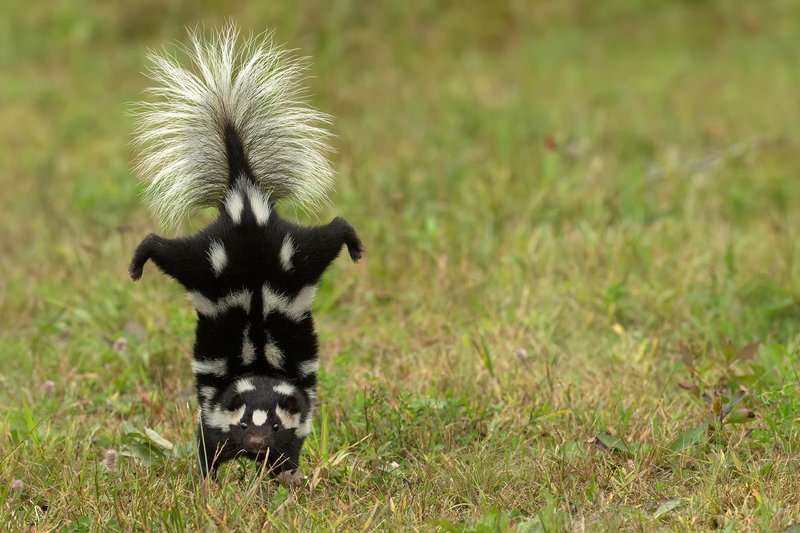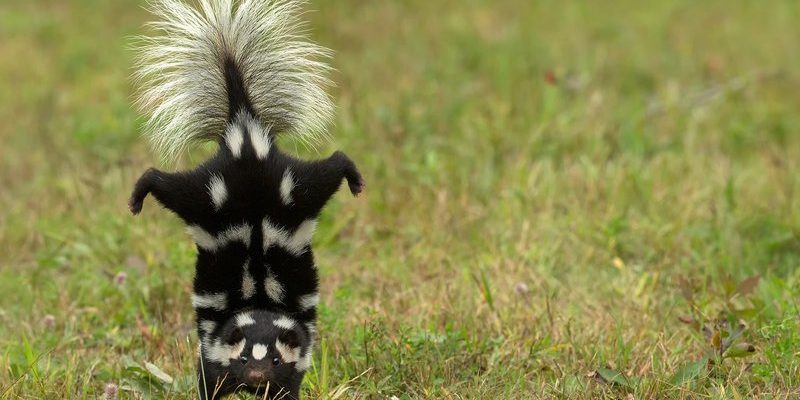
The Eastern Spotted Skunk is a fascinating little creature that often gets overshadowed by its more famous cousins, the striped skunks. Imagine a small, agile animal that can perform acrobatic stunts and make you smile with its quirky appearance. With its bold black and white markings and playful personality, the Eastern Spotted Skunk is a treasure of the animal kingdom. These skunks may be small, but they pack a punch when it comes to their unique traits and behaviors.
In this article, we’ll dive deep into the world of the Eastern Spotted Skunk. We’ll explore their habits, habitats, diets, and even their quirky antics. If you’re curious about these little critters or simply want to know more about wildlife in your area, you’re in the right place. So, grab a cup of coffee and let’s chat about this remarkable animal you might not think about every day!
Physical Characteristics
The Eastern Spotted Skunk is known for its distinctive appearance. Typically, it has a relatively small body measuring around 20 to 30 inches in length, including its bushy tail. The fur is primarily black with bold white spots or stripes that give it a unique look—almost like nature’s own art piece. These adorable skunks weigh in at about 4 to 10 pounds, making them smaller than their striped cousins, which makes them even more intriguing.
One of the standout features of the Eastern Spotted Skunk is its long, pointed nose and big, expressive eyes. It’s as if they were designed for the ultimate cuteness overload! Their feet are also quite interesting; they possess long claws that help them dig and climb, enabling them to explore their environments with ease. You might even catch them doing a little dance or handstand when they feel threatened, which just adds to their charm.
Overall, their physical characteristics aren’t just for show; they help these skunks adapt to their environments and defend themselves when necessary. It’s fascinating to think about how these traits have evolved over time, allowing them to thrive in various habitats.
Habitat and Distribution
When it comes to habitat, the Eastern Spotted Skunk is quite adaptable. You’ll typically find them in forested areas, grasslands, and even near urban spaces as long as there are places to hide and hunt. They prefer places with plenty of cover, such as dense brush, which provides safety from predators and serves as a great hunting ground for their diet.
Geographically, these skunks are mainly found in the eastern United States, stretching from the Midwest down to the Southeast. They are particularly fond of areas where they can find both wooded regions and open spaces. Knowing their habitat preferences can make spotting one in the wild a bit easier if you know where to look!
Interestingly, Eastern Spotted Skunks also take to trees with ease. While many think of skunks as ground dwellers, these agile little creatures can climb quite well. This makes them versatile and capable of navigating different landscapes, from scraggly forests to suburban backyards. In a world where many animals are losing their habitats, the adaptability of the Eastern Spotted Skunk is a fascinating survival story.
Diet and Behavior
The Eastern Spotted Skunk is an omnivore, which means they have a varied diet that consists of both plants and animals. They primarily feast on insects, small mammals, fruits, and berries. Their keen sense of smell helps them find food, while their dexterity allows them to dig for grubs or snatch fruit right off the ground. You might think of them as nature’s little foragers, always on the lookout for the next snack!
Behavior-wise, these skunks tend to be solitary creatures, although you might catch them interacting with others during mating season. They are mostly nocturnal, meaning they are active at night and rest during the day, which is when they find shelter in burrows or under fallen trees. Their nighttime antics can be quite entertaining to observe—if you’re lucky enough to spot one!
One of the most interesting aspects of their behavior is their ability to spray a foul-smelling liquid as a defense mechanism. However, they don’t just spray without warning. Eastern Spotted Skunks often perform a series of theatrical displays, including handstands and foot stomps to warn potential threats before resorting to their infamous spray. This combination of playfulness and caution makes them truly unique animals!
Reproduction and Lifecycle
The reproductive habits of the Eastern Spotted Skunk can be quite fascinating. Breeding generally occurs in late winter to early spring, and after a gestation period of about 60 days, a female skunk typically gives birth to a litter of three to six kits. These little ones are born blind and entirely dependent on their mother for the first few weeks of life. It’s heartwarming to think about how nurturing these skunks can be.
As the kits grow, they begin to explore their surroundings and learn vital survival skills from their mother. By the time they are around 8 to 10 weeks old, the kits start accompanying their mother on hunts. This learning period is crucial as they gather the knowledge they need to thrive in the wild. Once they reach maturity, they’ll venture out on their own, marking the beginning of their independent lives.
The lifespan of an Eastern Spotted Skunk in the wild is typically around 3 to 5 years, though some may live longer in protected environments. Understanding their lifecycle helps highlight the importance of protecting their habitats, ensuring that future generations of these adorable skunks can continue to thrive.
Conservation Status
When we talk about conservation, the Eastern Spotted Skunk presents an interesting case. While they aren’t currently categorized as endangered, they face threats that could impact their populations. Habitat loss due to urbanization, agriculture, and deforestation is a significant concern. As they lose their natural habitats, it becomes harder for these skunks to find food and shelter.
Additionally, Eastern Spotted Skunks are also susceptible to road accidents and domestic animal attacks. As humans expand our presence into their territories, it’s essential to remain aware of their needs and challenges. Conservation efforts can help mitigate these issues, such as creating wildlife corridors that allow skunks and other animals to travel safely between fragmented habitats.
By raising awareness about the Eastern Spotted Skunk and promoting habitat conservation, we can play a part in ensuring that these charming creatures continue to inhabit our landscapes for generations to come. It’s a collective responsibility that starts with understanding and appreciating the wildlife sharing our spaces.
Interesting Facts
| Fact | Description |
| Size | 20 to 30 inches long, including the tail |
| Weight | 4 to 10 pounds |
| Habitat | Forested areas, grasslands, and urban spaces |
| Diet | Insects, small mammals, fruits, and berries |
| Lifespan | 3 to 5 years in the wild |
| Activity | Nocturnal, most active at night |
| Defense Mechanism | Sprays foul-smelling liquid when threatened |
FAQ
Are Eastern Spotted Skunks dangerous to humans?
Generally, Eastern Spotted Skunks are not dangerous to humans. They are shy and prefer to avoid confrontation. If they feel threatened, they will usually try to escape rather than attack. It’s crucial to respect their space, as they can spray if they feel cornered. However, they aren’t aggressive by nature and poses minimal threat if left undisturbed.
What do Eastern Spotted Skunks eat?
Eastern Spotted Skunks have a varied diet that includes insects, small mammals like mice, fruits, and berries. As omnivores, they adapt their diet based on the availability of food in their habitat. This flexibility is one of the reasons they can thrive in diverse environments.
How can you spot an Eastern Spotted Skunk in the wild?
Spotting an Eastern Spotted Skunk can be tricky since they are primarily nocturnal. However, keep an eye out for their distinctive black and white markings and look for signs of their activity, such as footprints or dug-up soil. Listening for their characteristic sounds at night might also alert you to their presence.
Do Eastern Spotted Skunks hibernate?
No, Eastern Spotted Skunks do not hibernate. Instead, they are active throughout the year but tend to be less active in cold weather. During particularly harsh winters, they may reduce their activity levels and spend more time in their dens to keep warm.
Are Eastern Spotted Skunks social animals?
Eastern Spotted Skunks are generally solitary animals. While they may interact during mating season, they prefer to live and hunt alone. This solitary lifestyle helps them avoid competition for food and resources.
How do Eastern Spotted Skunks defend themselves?
Besides their infamous spray, Eastern Spotted Skunks have a range of defensive behaviors. They often perform dramatic displays, like handstands and foot stomps, to warn potential threats. If those don’t work, they can spray a strong-smelling liquid as a last resort.
What is the Eastern Spotted Skunk’s main predator?
Eastern Spotted Skunks have several natural predators, including owls, hawks, and larger mammals like foxes. Due to their small size, they must be cautious and rely on their ability to hide and escape to avoid becoming prey.
Can Eastern Spotted Skunks be kept as pets?
Keeping an Eastern Spotted Skunk as a pet is not recommended. They have specific habitat, dietary, and social needs that are difficult to meet in a domestic setting. Moreover, in many places, it’s illegal to keep them as pets. They are best appreciated as wild animals in their natural habitats.
What sound do Eastern Spotted Skunks make?
Eastern Spotted Skunks can produce a variety of sounds, including growls, grunts, and whistles. These sounds are used to communicate with one another and can serve as warnings to potential threats. Each sound carries its own meaning within their social interactions.
What is the difference between Eastern Spotted Skunks and striped skunks?
While both belong to the same family, Eastern Spotted Skunks and striped skunks differ in appearance and size. Eastern Spotted Skunks are smaller and feature distinctive spots, while striped skunks have prominent stripes along their backs. Their behaviors and habitats can also vary, with striped skunks being more adaptable to urban environments.
How do Eastern Spotted Skunks contribute to their ecosystem?
As omnivores, Eastern Spotted Skunks play an essential role in their ecosystem by helping control insect and small mammal populations. They also contribute to seed dispersal through their fruit consumption, supporting plant diversity. Their presence is vital for maintaining the balance within their habitats.

